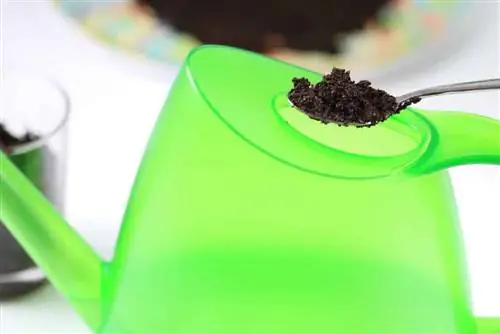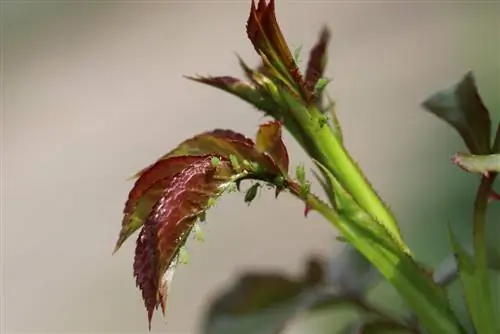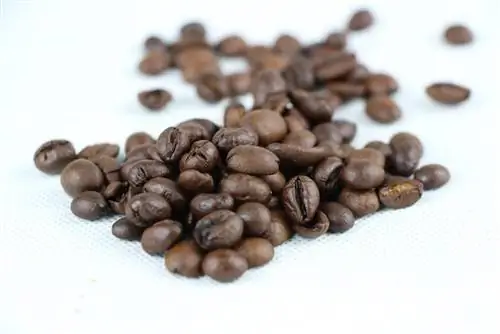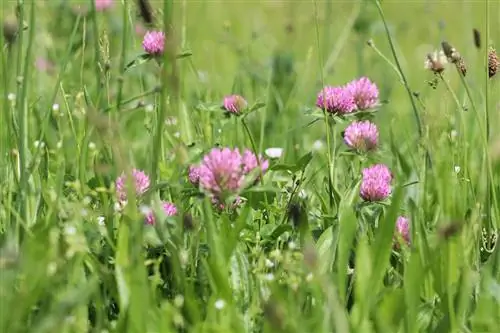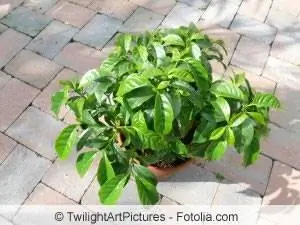- Author admin [email protected].
- Public 2023-12-17 03:39.
- Last modified 2025-06-01 06:48.
If you want to dry coffee grounds as flower fertilizer, you are using an often wasted resource. Valuable ingredients but also a potentially deterrent effect on pests are contained in the coffee leftovers. In order for these to be used beneficially, they must first be prepared appropriately. Interested hobby gardeners will find out what is important and what coffee grounds can be used for in detail below.
Ingredients
People appreciate coffee primarily because of its caffeine content, but it also has more to offer plants. The most important ingredients that make it a high-quality fertilizer are:
- Nitrogen
- Phosphorus
- Potassium
There are also tannic acids and antioxidants, which can also have a positive effect on the growth and he alth of plants.
Nitrogen
Nitrogen is particularly beneficial for leaf growth and is therefore contained in many fertilizers. This valuable ingredient is needed by all plants. The coffee grounds already contribute to plant he alth through this substance.
Phosphorus
From the formation of flowers to the ripening of the fruits - plants rely on phosphorus here. The mineral is particularly important for flowering plants, vegetables and fruit.
Potassium
In order for plants to be and remain stable, they need he althy cell walls. Potassium is required for their formation. The mineral therefore contributes directly to stability and stable growth.
tannic acid and antioxidants
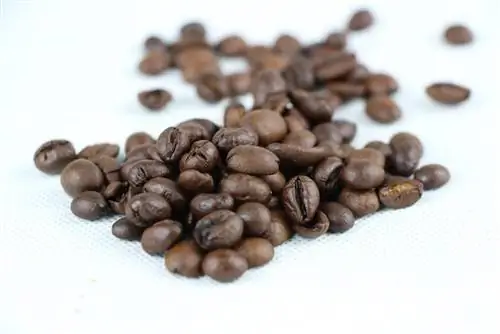
Tanneic acids have a slightly acidic effect and therefore have a neutralizing effect on lime. This can be an advantage. Antioxidants, on the other hand, serve to protect cells and can reduce the risk of damage - for example from environmental toxins, pollutants but also sunlight.
When using coffee grounds as fertilizer, these and other substances, such as caffeine, are said to have a stimulating and protective effect, just as they do in humans.
Drying
Anyone who owns a fully automatic coffee machine or has ever forgotten the filter bag in the machine knows how quickly coffee grounds mold. Of course, it can no longer be used as fertilizer. Therefore, the formation of mold must be urgently prevented, for which the damp powder simply has to be dried. There are various options available for this purpose:
- Spread the coffee grounds thinly, for example on a tray or a flat, open container and air dry
- Crumble pressed coffee grounds, for example from fully automatic machines or espresso machines, and dry them on a plate
- Heat on a baking tray in the oven at 50 to 100°C for half an hour
- Cook in the microwave for at least 5 minutes at medium power
It is important that there is no residual moisture in the coffee grounds afterwards, otherwise they will be a suitable breeding ground for mold spores despite the treatment. This is particularly annoying if larger quantities have already been collected and stored carefully - but then become unusable due to mold.
Storage
Whether coffee grounds are produced every day or just a few times a week - they are generally not used immediately as fertilizer. Especially when used in the garden, it only seems to be worth using in larger quantities. For this purpose, the fertilizer from the coffee machine is finally dried.
In addition to this measure, it must also be stored correctly. The following points are important:
- Dry the coffee grounds properly. It's best to crumble it very finely and lay it out thinly. It should then be powdery again and flow easily and should not become moist at all.
- Allow the dry coffee grounds to cool thoroughly and then pour them into an airtight container. Do not close the container if there is still moisture visible on the inner surface.
- Store the container closed, dry, cool and dark - for example in the refrigerator.
Tip:
If the coffee grounds are produced every day and are used relatively quickly as fertilizer, they do not need to be stored in a container. However, care should still be taken to ensure that it can dry sufficiently and remains dry.
Compost
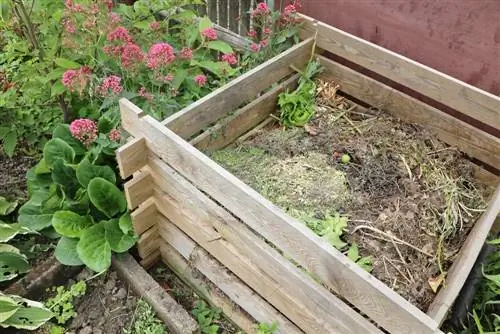
The easiest way to use coffee grounds as a versatile fertilizer and to use its valuable ingredients is to add it to compost or used soil. Here too, the coffee grounds should not be used wet if possible, as then there is a risk of mold forming.
In addition, for the same reason, it must be well distributed in the compost or substrate. If it is simply thrown up as a layer on top, fungal spores could still spread on it and make the soil unusable.
Fertilizer
Coffee grounds can be used as direct fertilizer in two ways. Both variants are common. On the one hand, it can be used dry, but should then be lightly worked into the soil or only spread very thinly over it. Repotting can be used for potted and container plants. In the garden or when planting outdoors, the dry coffee grounds can be scattered thinly around the plants and the soil can be lightly raked.
The second option is liquid fertilization with coffee grounds; for this it does not have to be dried in advance - as long as it is used directly, ideally added directly from the coffee machine to the irrigation water. However, there shouldn't be too many coffee grounds. One to two tablespoons per liter of water is sufficient. In order to derive the greatest possible benefit from it, the coffee grounds and water mixture should be allowed to stand for at least a few hours or even a day and should also be stirred before pouring.
Basic soil
In addition to being used as fertilizer, coffee grounds can also be used to slightly acidify or neutralize very alkaline soil. It is used for this purpose because of the tannic acids it contains. Of course, it should be noted that the nutrient content of the substrate also increases.
Hard water
Just like alkaline soil, calcareous water is also “hard”. Some plants do not have this pH value range. If the plants need soft water or an acidic or neutral substrate, coffee grounds can be of good use. It can be added to the irrigation water or the soil as described.
Tip:
In order to adjust the dosage if necessary, not to risk acidification and to create optimal conditions for the plants, the pH value of the soil should be checked regularly.
Suitability
Due to the slightly acidifying effect, coffee grounds are particularly suitable as flower fertilizer for plants that prefer an acidic pH value. These include:
- Azalea
- Berries
- Angel Trumpet
- Cucumber
- hydrangea
- Pumpkin
- Rhododendron
- Rose
- Tomato
- Zucchini
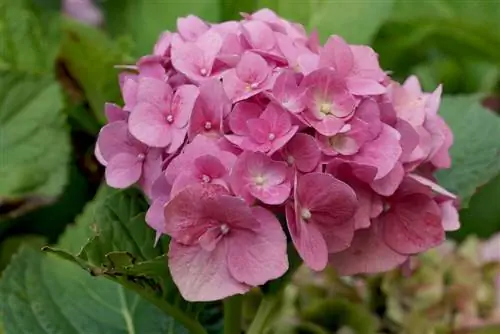
Whenever soil is too alkaline or water is too hard, coffee grounds can also be used as fertilizer. If the soil is already very acidic, attention should be paid to the tolerance of the plants so as not to risk acidification.
Dosage and frequency
Soil and plants can hardly be over-fertilized with coffee grounds, as long as they are not applied in very large quantities or too frequently. As a rule of thumb, houseplants can be fertilized with coffee grounds twice a year and garden plants up to four times a year. The additional nutrients should be given during growth.
It is also important that the coffee grounds are not incorporated into the substrate by the kilo, even without the risk of over-fertilization. Even if the nutrients do not become a problem, the risk of the soil becoming mold increases. If the substrate is already moist, coffee grounds should be used sparingly as fertilizer. If the soil is dry, it may be a little more. In general, it makes sense to initially only use a mixing ratio of one part coffee and ten parts earth and only increase the amount when this mixture is well tolerated.
Tip:
Coffee grounds behave a little differently in the compost. There can be a little more here. Soil organisms that are useful during decomposition are even attracted to it. However, as mentioned, it should be well distributed and not applied as a layer.
Deterrent
Due to its valuable ingredients, coffee grounds not only have good properties as a flower fertilizer, they are also said to have other positive effects.
For example, it is intended to keep certain types of snails away and could therefore prove to be a deterrent border around the vegetable patch or individual plants. Coffee grounds do not provide absolutely safe and guaranteed protection, but it is worth a try. If it does not bring the desired result, it can still be incorporated into the soil as fertilizer.
A similar effect can be achieved with coffee grounds on cats. Since they don't particularly like the smell, beds should be protected from serving as cat litter boxes. But be careful: some cats simply jump over the border made of coffee powder.
If wasps bother eating outside again, the coffee grounds should also be of good use. It is lit in a flat, fireproof bowl and used as incense. Although it no longer smells particularly pleasant of coffee, it is supposed to keep the wasps away efficiently.
Conclusion
Coffee grounds can be used in a variety of ways as a vegetable and flower fertilizer and even in the garden. The only thing that needs to be ensured is that the coffee grounds are properly prepared, stored and used in appropriate quantities so that they do not pose an increased risk of mold formation.

